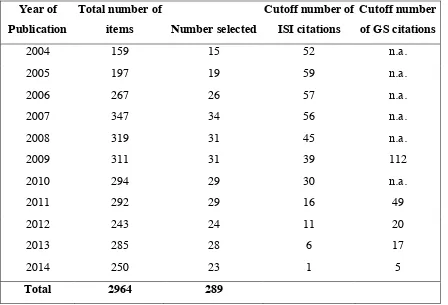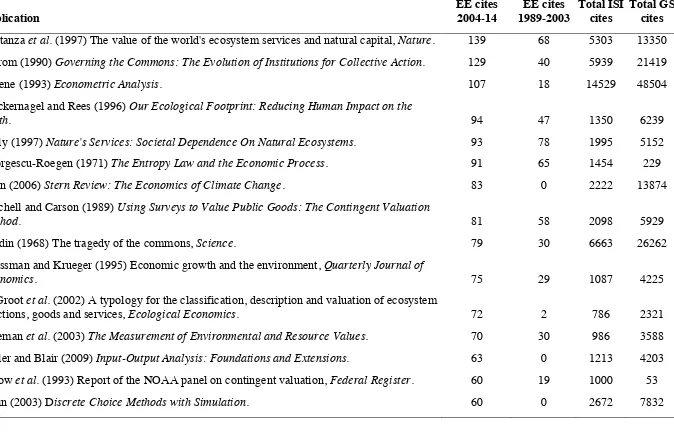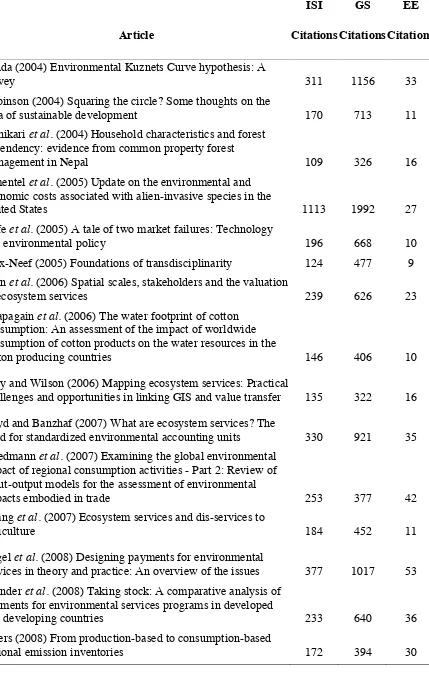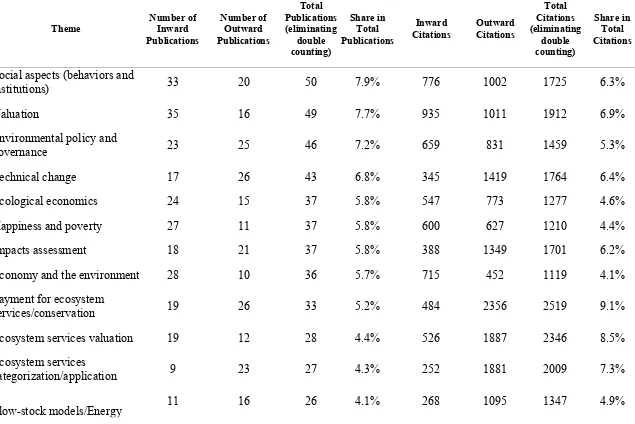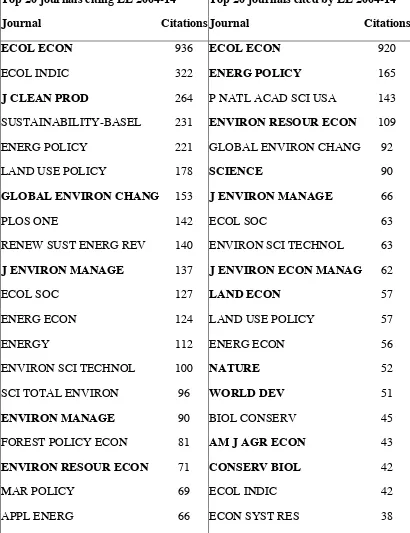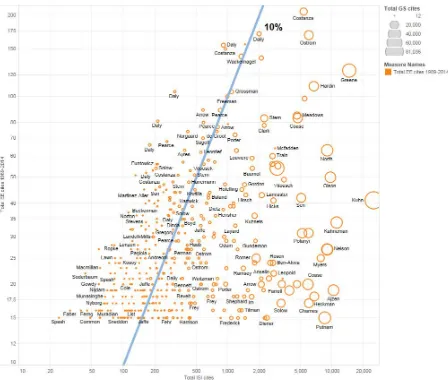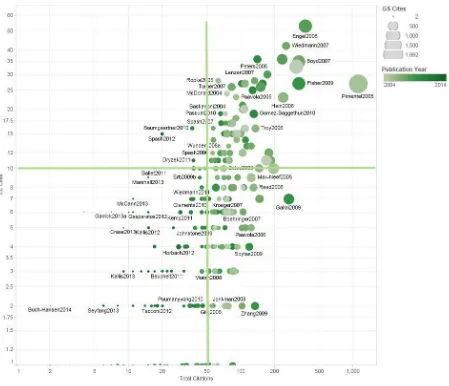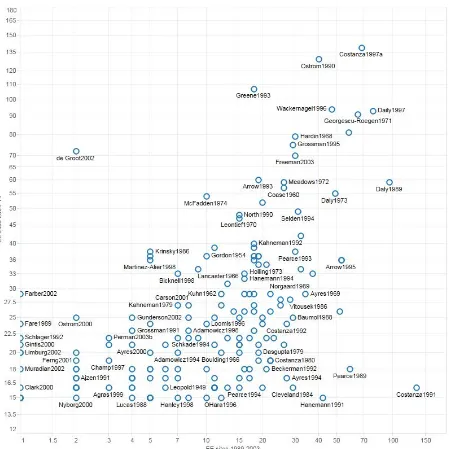Influential Publications in Ecological
Economics Revisited
Costanza, Robert and Howarth, Richard B. and
Kubiszewski, Ida and Liu, Shuang and Ma, Chunbo and
Plumecocq, Gaël and Stern, David I.
The Australian National University, Dartmouth College, CSIRO,
University of Western Australia, INRA
27 September 2015
Robert Costanza
Crawford School of Public Policy, The Australian National University, Acton, ACT 2601, Australia.
Richard B. Howarth
Environmental Studies Program, Dartmouth College, Hanover, NH 03755, USA. Ida Kubiszewski
Crawford School of Public Policy, The Australian National University, Acton, ACT 2601, Australia.
Shuang Liu
Land and Water Flagship, CSIRO, Canberra, ACT 2601, Australia. Chunbo Ma
School of Agricultural and Resource Economics, University of Western Australia, Perth, WA 6009, Australia.
Gaël Plumecocq
INRA, UMR 1248 Agir, BP 52627. F- 31326 Castanet-Tolosan Cedex, France. David I. Stern
Crawford School of Public Policy, The Australian National University, Acton, ACT 2601, Australia.
Corresponding author: david.stern@anu.edu.au 27 September 2015
Abstract
We revisit the analysis of Costanza et al. (2004, Ecological Economics) of influential
publications in ecological economics to discover what has changed a decade on. We examine which sources have been influential on the field of ecological economics in the past decade, which articles in the journal Ecological Economics have had the most influence on the field and on the rest of science, and on which areas of science the journal is having the most influence. We find that the field has matured over this period, with articles published in the journal having a greater influence than before, an increase in citation links to environmental studies journals and a reduction in citation links to mainstream economics journals, and possibly a shift in themes to a more applied and empirical direction.
Ecological economics is a transdisciplinary field of study. It is influenced by and has
influence on a broad range of disciplines and topics. We revisit the analysis of Costanza et al. (2004) of influential publications in ecological economics to discover what has changed a
decade on. We compare our findings with this previous work to determine how the journal
and the field have changed in the intervening period. We analyze what literature has had the
most influence on the field in the last decade, as indicated by citations made by articles
published in Ecological Economics (EE), and which publications in the journal have had the most influence both on the field and on the wider scientific community. We also look at the
most common topics of the influential papers to find which are the most important current
topics in the field.
An important caveat regarding our analysis is the question of whether the changes we find are
due to changes in the field of ecological economics or due to changes in the management of
the journal, Ecological Economics, and the market for publications in the field. In 2004, Robert Costanza had been editor for all but one year of our sample. In the past decade, Cutler
Cleveland and Richard Howarth have been the editors. The numbers of submissions and
published articles have both increased strongly and the journal has become more selective.
There are also more alternative outlets for publications in this field.
2. Literature Review
Costanza et al. (2004) carried out an analysis along similar lines to the current study and found a broad range of influences on the field of ecological economics. As the field was still
quite young, inward influence from classic articles in the broader environmental and
economic literature were more influential on the field than were the articles actually
published in EE. But the authors argued that this was likely to change as the field matured, as some articles published in the journal were receiving high numbers of citations per year. So,
it is interesting to now follow up on that prediction.
Ma and Stern (2006) followed up Costanza et al.’s analysis by comparing EE and the Journal of Environmental Economics and Management (JEEM) in order to understand the differences between transdisciplinary ecological economics and mainstream environmental economics.
environmental economics cites more heavily from journals rather than other publications, and citations in environmental economics are more concentrated on particular journals and
individual publications.” (p491) There was much less similarity at the level of individual articles: “Non- market valuation articles dominate the most cited articles in JEEM while green accounting, sustainability, and the environmental Kuznets curve are all prominent topics in EE.” (p491) We are interested in finding out whether the pattern of citation links to the natural science literature has been sustained or not and how the topics of influential articles have evolved.
Castro e Silva and Teixeira (2011) showed how the topics covered in EE evolved from 1989 to 2009.They “note that ecological economics experienced an ‘empirical turn’ reflected in a
shift away from exclusively formalized papers towards exclusively empirical and, to a larger
extent, ‘formal and empirical’ ones” (p849). An interesting question is whether there has also
been such a shift in influential papers or whether theoretical papers remain the more
influential.
Hoepner et al. (2012) revisited the question of influential publications in environmental and ecological economics covering articles published in a group of 14 environmental and
resource economics journals including EE in the period from 2000 to 2009. Their main indicator is citations per annum, which gives recently published papers more equal weight
and they distribute citations to authors and institutions on a fractional basis. They rank
individual publications, authors, journals, and institutions with sometimes counterintuitive
results. For example, Costanza ranks as the 61st
most influential author. Spash (2013)
criticized this analysis mainly for combining ecological and environmental economics
together and thus giving a heavier weight to mainstream environmental economics, as more
such journals were included. As Spash stated, Hoepner et al.’s (2012) research design
excludes important influences on ecological economics that are outside of the economic
mainstream. These are included in our study.
Plumecocq (2014) compares ecological economics research published in EE and
Environmental Values with research published in JEEM and Environmental and Resource Economics using textual data analysis. His results “point to the increasing importance of the evaluation of ecosystem services in ecological economic discourse”. This causes him to
results will show how the topics covered by the most cited papers in the field, including
ecosystem services valuation, have evolved in the last decade.
3. Methods and Data
3.1. Identifying the influential publications
The main analysis in this paper is based on a set of the most influential articles that we
constructed as described in the following. First, we distinguish between inward and outward
influence. Inward influence occurs when publications are cited in articles published in EE. Outward influence occurs when articles published in EE are cited in other publications.
To measure inward influence, we compile a database of all the sources cited in articles in EE
over the 11 years, 2004-2014, and select the most cited sources. We limited these to all
articles that received more than 15 citations in the journal in the period. We excluded
institutional authors such as the IPCC and UN. We also collected the total number of
citations to the identified publications in the Web of Science (WoS) as a whole and in Google Scholar (GS). We used a variety of techniques to ensure that we had a comprehensive list of publications that received more than 15 citations in the journal in the period, and all of the
citations to a publication were counted. First, we made a substantial effort to identify
orphaned citations – citations to an article that should have been added to the total but were
listed separately because of small variations in the recorded details of the publication. We
examined all publications that have 10 or more citations and combined all orphaned citations.
This gives a more comprehensive list of articles that received more than 15 citations. For
journal articles that have correct DOIs, we used these DOIs to identify the articles and collect
the associated WoS citations. For journal articles whose DOIs were missing or entered into the database incorrectly, we used a combination of the author’s name and year of publication
to identify the publication and collect its WoS citations.
For monographs and edited books, we followed the approach used by Costanza et al. (2004). The titles of monographs and edited books recorded in the WoS database show substantial variation. We first searched for the author’s or editor’s name(s) together with the publication
year in order to pick up all the variations on a title in the WoS database. Next, we searched for all these variations of the titles without the year and the author’s and editor’s name(s). This
yields a large list of possible references to the volume. For example, we first searched for
Cited Author: Rawls J*
Cited Year (s): 1971
This search identified 57 title entry variations, which we then used for the next search using
the “Cited Work” search.1
We collected WoS and GS citations to journal articles between April 17 and 23, 2015. GS
citations to books were collected on 3 May 2015, and WoS citations to books were collected between 17 April and 19 May 2015.
To measure outward influence, we examined the citations received by all articles published in
the journal in the same period. We downloaded data on all the articles published in
Ecological Economics in the designated period from WoS on 26 February 2015. The data include all citations included in the database up to that date. We found a total of 2960
published items for the 11 years of the sample. For the period from 1989 to 2003 there were
1364 items. We identified the most influential individual articles published in the journal
based on citations in WoS as a whole. To deal with the varying age of articles and their corresponding variation in potential to be cited, we use the Thomson-Reuters “highly-cited”
approach of picking the top fractile of most cited publications of all the publications in a
given year (Thomson Reuters, 2014). Though this selects papers in recent years that have low
1
The search terms entered in this case were: Cited Work: 'THEORY JUSTICE' OR '1971: A Theory of Justice' OR '1971: A Theory of Justice' OR '7HEORY OFJUSTICE' OR 'THEORY JUST' OR 'THEORY JUSTICE ROUTL' OR 'A THEORY OF JUSTICE' OR 'THEORY JUSTICE REV E' OR 'A theory of justice (Théorie de la justice) ' OR 'A theoryofjustice' OR 'THEORY SOCIAL JUSTIC' OR 'ATHEORY JUSTICE' OR 'J RAWLS THEORY JUSTI' OR 'THEORY JUSTICE' OR 'PREFACE THEORY JUSTI' OR 'STHEORY JUSTICE' OR 'TEORIA GIUSTIZIA' OR 'TEORY JUSTICE' OR 'THEOLY JUSTICE' OR 'THEOR JUSTICE' OR 'THEORIE GERECHTIGKEI' OR 'THEORY JSUTICE' OR 'THEORY JUCTICE' OR 'THEORY JUSETICE' OR 'THEORY JUSINCE' OR 'THEORY JUSITCE' OR 'THEORY JUSTIC' OR 'THEORY JUSTICD' OR 'THEORY JUSTICE 1' OR 'THEORY JUSTICE 90 91' OR 'THEORY JUSTICE CAMBR' OR 'THEORY JUSTICE FAIRN' OR 'THEORY JUSTICE OUP' OR 'THEORY JUSTICE OXFOR' OR 'THEORY JUSTICEE' OR 'THEORY JUSTICER' OR 'THEORY JUSTICEW' OR 'THEORY JUSTICS' OR 'THEORY JUSTICW' OR 'THEORY JUSTIDE' OR 'THEORY JUTICE' OR 'THEORY OFJUSTICE' OR 'THEORY PRACTICE' OR 'THEORY USTICE' OR 'THEORYJUSTICE' OR
numbers of citations so far, Stern (2014) shows that early citations are quite strongly
correlated with long-run cumulative citations and so many of these papers will turn out to be
very influential. Costanza et al. (2004) selected 71 highly cited articles from the journal, which is about 5% of the total. We decided to extend coverage to 10% of items in each year.
We also collected the number of GS citations to each of the identified influential articles. We collected GS citations to these articles on 6 March 2015. If the borderline between the top 10% and the rest of the articles falls inside a group of articles with a common number of
citations we use the number of GS citations received to determine the cut-off point within that group. If articles on both sides of the 10% line still have the same number of GS citations, we then remove those articles that share the same number of citations as those over the
borderline. This made the most difference to the 2014 articles where many articles have only
one citation. Table 1 presents the number of articles selected in each year and the cutoff
points in terms of citations used in each year. We also counted the number of citations these
articles received in EE alone.
3.2. Identifying the influential themes
We identify the importance of the various subject themes of the most inwardly and outwardly
influential publications by attaching a theme to each of the 679 most influential publications
that we identified. After eliminating duplicate publications that appear both in the inward and
in the outward influence lists, we obtained 635 unique influential publications. These
publications are then clustered following a descending hierarchical classification method
(Reinert, 1983) applied to the words used in the titles of these publications. This clustering technique proceeds from a contingency table that enables us to count the presence or absence
of words in a given title. All the words found in the titles (except pronouns, conjunctions, and
some adjectives) are placed in rows; the 635 unique publications are placed in the columns.
The hierarchical descending classification commences by splitting the ensemble of columns
into two contrasting groups in terms of the presence or absence of the occurrence of words.
These two clusters then contain mutually exclusive vocabulary so that words present in one
cluster are relatively absent in the other one, and vice versa. We test whether there is a significant difference in the relative abundance of a word inside and outside the cluster using
a chi-square test evaluated at the 5% significance level. The classification then proceeds via
an iterative process: the largest of the two clusters in terms of number of publications is
divided; etc. The iterative process stops either when the number of clusters predefined by the
analyst is reached, or when no significantly different vocabulary can be found in the largest
cluster. We repeated this iterative process by progressively increasing the number of clusters
requested so as to get the finest possible clustering. In our case, we obtained 53 clusters. We
then label the clusters according to their main theme words, and proceed to reallocate
publications that have been misplaced and to amalgamate clusters that are very close in
theme.2
Using this algorithm, we obtained 22 clusters (i.e. 22 themes). Only 5 publications remain
unclustered. Table 2 presents the full list of 22 clusters (themes) and some statistics.
3.3. Journal level data
In addition to this main analysis, we repeat the analysis of Ma and Stern (2006) on which
journals are most cited by EE and which journals cite EE most using data from the Journal Citations Report for the period 2004 to 2014.
4. Results
4.1. Inward influence
Table 2 lists details of the top 30 publications regardless of when they were published ranked
by number of EE cites in the 2004-14 period. Figure 1 is a log-log plot of the number of WoS
cites vs. the number of EE cites for all the articles we included in our survey of inward influence, along with an indication of the number of GS cites by the size of the circles. It also
shows the line where the number of EE cites is 1/10 of the number of WoS cites. Publications to the right of this line are 10 times or more cited in WoS relative to in EE.
One striking difference between this Figure and Figure 2 is the relative lack of correlation
between WoS and EE cites in Figure 1 compared to Figure 2. There are many articles in the group with very high WoS cites but relatively low EE cites. These are publications such as
2
Two types of misclassification were found. First, some clusters were formed on the basis of artifacts. For instance, publications using the word “question”, and no other word
significantly associated to other classes were clustered together, although they really belonged to very different themes. Second, some clusters might attract publications
Kuhn’s (1962) book The Structure of Scientific Revolutions that are very highly cited in general but have had only a moderate influence on EE.
Costanza et al. (1997) was the most highly cited publication in EE in the 2004-14 period, and the second highest in the 1989-2003 period after Daily (1997), an edited book, both of these
on the topic of ecosystem services. It is also notable how many of the top items are books
(including Ostrom (1990), Daily (1997), Stern (2006), etc.). This is not surprising, since
books in general garner higher overall citations than journal articles (LSE Public Policy
Group, 2011). Only two articles published in EE appear in this top thirty list - de Groot et al. (2002) and Engel et al. (2008) – both of which are also on the topic of ecosystem services.
Figure 3 is a log-log plot of the relationship between EE citations in the 1989-2003 vs. EE
citations in the 2004-2014 period to show which articles have had continuing influence on EE
citations. This plot, of course, only includes articles published before 2003. Most of these
publications have continued to have ongoing influence. A few exceptions that have had
waning influence with relatively fewer citations in the later period include Hanemann (1991),
Pearce et al. (1989), and Costanza (1991), all “foundational” books.
The most inwardly influential publications in the 1989-2003 period dealt with the themes of
ecological economics (15.6%), and conservation, ecosystems, biodiversity, and species
(11.7%). Altogether these two themes represent only 9.5% of the citations in the second
period. Instead the themes that became influential are valuation (9.5%), social aspects of
environmental issues, including behavioral and institutional dimensions (7.9%), and the
exploration of the relationships between the economy and the environment (7.3%).
4.2. Outward influence
Table 3 lists the top three articles published in EE ranked by WoS citations in each of the years 2004 to 2014 and their EE, WoS, and GS citations. Figure 2 is a plot of the outward influence of the most highly cited papers published in EE in the 2004-2014 period. The chart shows total WoS citations on the x-axis vs. total EE citations on the y-axis, with the size of the circles indicating the number of GS citations and the color of the circles indicating the year of publication. The most highly cited article published in EE across the eleven years in both WoS and GS is Pimentel et al.’s (2005) article on the economic costs of invasive species. This article also has the highest average citations per year. However, it is not the most cited
environmental service payments (PES). This shows a divergence between outward and
inward influence that will be explored further below. Many of the most inwardly influential
papers in this group (i.e. papers that were both highly cited in EE and highly cited in general) are on PES. Engel et al.’s paper is also the second most outwardly influential paper (i.e. those cited in WoS) in terms of citations per year. 14 of the 33 top articles ranked by EE citations contain both the terms “ecosystem” and “service” or “environmental” and “service” in their
title and others appear to be on related themes, indicating the importance of this theme in EE
in this period. We also observe a fairly strong correlation between EE cites and WoS cites for these papers, indicating that highly cited papers in EE are also highly cited elsewhere, with an average ratio of about 5 WoS cites for every 1 EE cite. This indicates the broader influence of papers published in EE beyond the journal itself. This may also be because in the last 10 years the accessibility of journal articles has increased dramatically and where a paper is
published now has less influence on who reads it and cites it.
How have things changed since Costanza et al. (2004)? First, some of the articles in Table 3 and Figure 2 have very substantial WoS citations, which was not the case for articles
published in the journal prior to 2004. Pearce and Atkinson (1993) was the article that had
received the most WoS citations at that point – a total of 75. Second, the most popular topics among the top articles prior to 2004 were sustainable development and mainstream
environmental valuation methods as well as a number of papers on the foundations of
ecological economics (receiving 16.8% and 16.7%, respectively, of the citations of the
influential articles in the first period). These themes have changed dramatically, as shown in
Table 4. In the 2004-2014 period, the influential papers published in EE on the three themes related to ecosystem services (payment for, valuation, and categorization) received the largest
number of citations (12.6%, 10.1%, and 10%, respectively, 32.7% altogether), while
sustainable development and ecological economics decreased in importance and received
only 6.5% and 4.1% of the citations to influential articles, respectively.
4.3. Influential themes
Table 4 shows the results of the thematic clustering procedure. The largest cluster - on the
theme of “behaviors and institutions” - contains 50 publications, closely followed by 49
publications on “valuation.” The smallest cluster - on the theme of “land use” - contains 9
publications. However, if we aggregate the three themes related to ecosystem services
indicating the prevalence of this topic. In terms of citations, these three themes together had
25% of the total citations (an average of 78 citations per paper for these themes, compared to
43.4 citations on average for all identified influential publications), with the next largest
cluster – “valuation” – having only 6.9% of total citations.
The number of applied themes does suggest that there has been a move away from the
dominance of the more foundational themes. However, it is hard to determine from the theme
analysis whether EE has produced more influential applied papers in the last decade than previously. We might expect theoretical or review papers to be more influential in EE.3 Looking at the top outward influential papers, we find theoretical or conceptual ones: Boyd
and Banzhaf (2007) and Fisher et al. (2009) provide classifications of ecosystem services, Engel et al. (2008) is an overview of concepts and issues in PES, Dinda (2004) is a survey of the environmental Kuznets curve, and Wiedmann et al. (2007) a review of input-output models. But, somewhat unexpectedly, other influential papers are more applied: Pimentel et al. (2005) study the economic cost of invasive species, Gallaï et al. (2009) calculate the value of pollination services, and Wunder et al. (2008) compare two PES schemes. While these studies are applied, their results and outcomes are very general so that they can easily be
mobilized in other research to provide overview data that helps in framing more specific
issues. Nevertheless, an analysis of the co-occurrence of the words contained in the titles
suggests that the growing influence of (payments for) ecosystem services is coupled with an
empirical trend. When splitting the timeframe into two periods, we can even distinguish two
phases of this evolution: under the editorship of Cutler Cleveland, 9% of the influential
publications associated the terms “theory” and “practice” in their titles; and 9% of the
influential papers published under the editorship of Richard Howarth (from 2008) contained
both the words “case” and “study” (ranked as the fifth most frequent association of words in
the titles of articles published since 2008). It also seems that the emergence and influence in
the last decade of themes such as PES or more broadly ecosystem services has led to more
applied papers, especially under Richard Howarth’s editorship (Table 3).
3
4.4 Journal level analysis
Table 5 uses data from the Journal Citation Reports to list the 20 journals that most
frequently cited EE and were most frequently cited by EE in the years 2004-2014. As noted by Ma and Stern (2006), EE cites the general science journals PNAS, Science, and Nature but is obviously cited by those journals much less. There is also a tendency to cite the
mainstream environmental and resource economics journals Environmental and Resource Economics, JEEM, Land Economics, and American Journal of Agricultural Economics but to be much less cited by them. However, this less pronounced than in 2003 when those four
journals were the four most cited in EE after the journal itself. Instead interdisciplinary environmental studies journals such as Global Environmental Change, J. Environmental Management, Ecology and Society, and Environmental Science and Technology are much more prominent. No core economics journal now appears in the top 20, whereas in 2003 the
American Economic Review, J. Political Economy, and Quarterly Journal of Economics all featured. Energy Policy now is the second most cited journal and Energy Economics also features in the top 20 list, reflecting the expansion of publication in energy economics and
policy in recent years. There has also been a reduction in the prominence of economics
journals in the list of the top 20 journals citing EE and a rise in interdisciplinary
environmental studies and energy journals as well as interdisciplinary mega-journal PLOS One.
5. Discussion and Conclusions
We have described and plotted the publications in the broader literature that have influenced
EE (inward influence) based on their citation rates in EE, and the influence of articles published in EE (outward influence) based on citation rates in both the journal itself and the broader literature (WoS and GS). We have also described how these citations have changed over time and how the citation rates of major themes covered in EE have changed over time. These patterns are complex, but we can draw a few conclusions.
EE is a unique, transdisciplinary, journal that cites and is cited by a broad range of other sources. In its first 14 years (1989-2003) it was building its reputation and the inward
influence in citations was much larger than its outward influence. This has changed to some
As for inward influence, publications in EE often cite publications from general
interdisciplinary natural science journals and books, again a testament to its transdisciplinary
nature. Citations to economics journals whether environmental and resource economics
journals or core economics journals have declined and environmental and resource
economics journals have also dropped down the citing journal list, as shown in Table 5.
Interdisciplinary environmental studies journals increasingly dominate both the cited and
citing journal lists.
EE is now 26 years old. Its themes and publication patterns have changed dramatically over that period, but it has retained its commitment over three editors to being a unique venue for
research that transcends disciplinary boundaries.
References
Arrow, K., B. Bolin, R. Costanza, P. Dasgupta, C. Folke, C. S. Holling, B.-O. Jansson, S.
Levin, K.-G. Maler, C. Perrings, and D. Pimentel (1995) Economic-growth,
carrying-capacity, and the environment, Science 268, 520– 521.
Boyd, J. and S. Banzhaf (2007) What are ecosystem services? The need for standardized
environmental accounting units, Ecological Economics 63: 616-626.
Castro e Silva, M. and A. A. C. Teixeira (2011) A bibliometric account of the evolution of
ecological economics in the last two decades: Is ecological economics (becoming) a
post-normal science? Ecological Economics 70(5), 849–862.
Costanza, R (ed.) (1991) Ecological Economics: The Science And Management of Sustainability, Columbia University Press, New York.
Costanza, R., D. I. Stern, B. P. Fisher, L. He, and C. Ma (2004) Influential publications in
ecological economics: a citation analysis, Ecological Economics 50, 261-292.
Cropper, M. L. and W. E. Oates (1992) Environmental economics: a survey, Journal of Economic Literature 30, 675-740.
Daily, G. (ed.) (1997) Nature’s Services: Societal Dependence on Natural Ecosystems, Island
Press, Washington, DC.
Daly, H.E. and J. B. Cobb (1989) For the Common Good: Redirecting the Economy Toward
Community, the Environment, and a Sustainable Future, Beacon Press, Boston.
de Bruyn, S. M., J. C. J. M. van den Bergh, and J.B. Opschoor (1998) Economic growth and
emissions: reconsidering the empirical basis of environmental Kuznets curves,
Ecological Economics 25, 161–175.
de Groot, R. S., M. A. Wilson, and M. J. Boumans (2002) A typology for the classification,
description and valuation of ecosystem functions, goods and services, Ecological Economics 41, 393–408.
Dinda, S. (2004) Environmental Kuznets Curve hypothesis: A survey, Ecological Economics
49: 431-455.
Engel, S., S. Pagiola, and S. Wunder (2008) Designing payments for environmental services
in theory and practice: An overview of the issues, Ecological Economics 65, 663-674.
Fisher, B., R. K. Turner, and P. Morling (2009) Defining and classifying ecosystem services
for decision making, Ecological Economics 68, 643-653.
Gallai, N., J.-M. Salles, J. Settele, and B. E. Vaissière (2009) Economic valuation of the
vulnerability of world agriculture confronted with pollinator decline, Ecological
Economics 68: 810-821.
Georgescu-Roegen, N. (1971) The Entropy Law and the Economic Process. Harvard Univ.
Press, Boston, MA.
Hanemann, WM. (1991) Statistical efficiency of double-bounded dichotomous choice
contingent valuation, American Journal of Agricultural Economics 73, 1255-1263.
Hanley, N. and C. L. Spash, (1993) Cost-Benefit Analysis and the Environment. Edward Elgar Publishing Limited, Aldershot, U.K.
Hausman, J. (ed.) (1993) Contingent Valuation: A Critical Assessment North-Holland, Amsterdam, The Netherlands.
Hoepner, A. G. F., B. Kant, B. Scholtens, and P.-S. Yu (2012) Environmental and ecological
economics in the 21st century: An age adjusted citation analysis of the influential
Hoepner, A. G. F., B. Kant, B. Scholtens, and P.-S. Yu (2013) Is the journal Ecological
Economics really in itself a poor and misleading guide to what ecological economics is
about? A reply to “Influencing the perception of what and who is important in
ecological economics” Ecological Economics 89, 174-176.
Lokker, C., K. A. McKibbon, R. J. McKinlay, N. L. Wilczynski, R. B. Haynes (2008)
Prediction of citation counts for clinical articles at two years using data available within
three weeks of publication: retrospective cohort study, British Medical Journal 336: 655-657.
LSE Public Policy Group (2011) Maximizing the Impacts of your Research: A Handbook for Social Scientists.
http://www.lse.ac.uk/government/research/resgroups/LSEPublicPolicy/Docs/LSE_Impa
ct_Handbook_April_2011.pdf
Ma, C. and D. I. Stern (2006) Environmental and ecological economics: a citation analysis,
Ecological Economics 58(3), 491-506.
Mitchell, R. C. and R. T. Carson (1989) Using Surveys to Value Public Goods: The
Contingent Valuation Method, Resources for the Future, Washington DC.
O’Hara, S. U. (1996) Discursive ethics in ecosystems valuation and environmental policy,
Ecological Economics 16, 95–107.
Pearce, D. W. and G. Atkinson (1993) Capital theory and the measurement of sustainable
development: an indicator of weak sustainability, Ecological Economics 8, 103-108.
Pearce D. W., A. Markandya, and E. B. Barbier (1989) Blueprint for a Green Economy, Earthscan, London.
Pearce, D. W. and R. K. Turner (1990) Economics of Natural Resources and the Environment,
Johns Hopkins Univ. Press, Baltimore, MD.
Pimentel, D., R. Zuniga, and D. Morrison (2005) Update on the environmental and economic
costs associated with alien-invasive species in the United States, Ecological Economics
Plumecocq, G. (2014) The second generation of ecological economics: How far has the apple
fallen from the tree? Ecological Economics 107, 457–468.
Reinert, M. (1983) Une méthode de classification descendante hiérarchique: application à
l'analyse lexicale par contexte, Les Cahiers de l'Analyse des Données 8, 187-198.
Spash, C. L. (2013) Influencing the perception of what and who is important in ecological
economics, Ecological Economics 89, 204–209.
Stern, D. I. (1998) Progress on the environmental Kuznets curve? Environment and Development Economics 3, 173-196.
Stern, D. I. (2014) High-ranked social science journal articles can be identified from early
citation information, PLoS ONE 9(11), e112520.
Thomson Reuters (2014) About Highly Cited Researchers. http://highlycited.com/info.htm
van Noorden, R., B. Maher, and R. Nuzzo (2014) The top 100 papers, Nature 514: 550-553.
Victor, P. A. (1972) Pollution: Economy and the Environment, University of Toronto Press.
Wiedmann, T., H. C. Wilting, M. Lenzen, S. Lutter, and V. Palm (2011) Quo Vadis MRIO?
Methodological, data and institutional requirements for multi-region input-output
analysis, Ecological Economics 70: 1937-1945.
Wunder, S., S. Engel, and S. Pagiola (2008) Taking stock: A comparative analysis of
payments for environmental services programs in developed and developing countries,
Table 1. Outward Influence: Selection Criteria
Year of
Publication
Total number of
items Number selected
Cutoff number of
ISI citations
Cutoff number
of GS citations
2004 159 15 52 n.a.
2005 197 19 59 n.a.
2006 267 26 57 n.a.
2007 347 34 56 n.a.
2008 319 31 45 n.a.
2009 311 31 39 112
2010 294 29 30 n.a.
2011 292 29 16 49
2012 243 24 11 20
2013 285 28 6 17
2014 250 23 1 5
Table 2. Inward Influence: The Top Thirty Articles
Publication
EE cites 2004-14
EE cites 1989-2003
Total ISI cites
Total GS cites
Costanza et al. (1997) The value of the world's ecosystem services and natural capital, Nature. 139 68 5303 13350
Ostrom (1990) Governing the Commons: The Evolution of Institutions for Collective Action. 129 40 5939 21419
Greene (1993) Econometric Analysis. 107 18 14529 48504
Wackernagel and Rees (1996) Our Ecological Footprint: Reducing Human Impact on the
Earth. 94 47 1350 6239
Daily (1997) Nature's Services: Societal Dependence On Natural Ecosystems. 93 78 1995 5152
Georgescu-Roegen (1971) The Entropy Law and the Economic Process. 91 65 1454 229
Stern (2006) Stern Review: The Economics of Climate Change. 83 0 2222 13874
Mitchell and Carson (1989) Using Surveys to Value Public Goods: The Contingent Valuation
Method. 81 58 2098 5929
Hardin (1968) The tragedy of the commons, Science. 79 30 6663 26262
Grossman and Krueger (1995) Economic growth and the environment, Quarterly Journal of
Economics. 75 29 1087 4225
de Groot et al. (2002) A typology for the classification, description and valuation of ecosystem
functions, goods and services, Ecological Economics. 72 2 786 2321
Freeman et al. (2003) The Measurement of Environmental and Resource Values. 70 30 986 3588
Miller and Blair (2009) Input-Output Analysis: Foundations and Extensions. 63 0 1213 4203
Arrow et al. (1993) Report of the NOAA panel on contingent valuation, Federal Register. 60 19 1000 53
Daly and Cobb (1989) For the Common Good. 59 96 904 4923
Meadows et al. (1972) The Limits to Growth. 59 26 4592 13013
Louviere et al. (2000) Stated Choice Methods: Analysis and Application. 59 0 1702 4461
Coase (1960) The problem of social cost, Journal of Law and Economics. 57 26 4636 25204
Daly (1973) Toward a Steady State Economy. 55 49 309 1417
McFadden (1974) Conditional logit analysis of qualitative choice behaviour, in: Frontiers in
Econometrics. 54 10 2829 152
Engel et al. (2008) Designing payments for environmental services in theory and practice: An
overview of the issues, Ecological Economics. 53 0 435 1049
Porter (1995) Toward a new conception of the environment-competitiveness relationship,
Journal of Economic Perspectives. 52 20 1178 4560
Stern (2004) The rise and fall of the environmental Kuznets curve, World Development. 51 0 478 1365
Selden and Song (1994) Environmental quality and development: Is there a Kuznets Curve for
air pollution emissions? Journal of Environmental Economics and Management. 49 31 585 2024
Daly and Farley (2004) Ecological Economics: Principles and Applications. 48 0 213 1303
North (1990) Institutions, Institutional Change and Economic Performance. 48 15 8919 35345
Leontief (1970) Environmental repercussions and the economic structure: An input-output
approach, Review of Economics and Statistics. 47 15 553 1459
Wunder (2005) Payments for Environmental Services: Some Nuts and Bolts. 44 0 310 1208
Table 3. Outward Influence: Top Three Articles by Year Article ISI Citations GS Citations EE Citations
Dinda (2004) Environmental Kuznets Curve hypothesis: A
survey 311 1156 33
Robinson (2004) Squaring the circle? Some thoughts on the
idea of sustainable development 170 713 11
Adhikari et al. (2004) Household characteristics and forest dependency: evidence from common property forest
management in Nepal 109 326 16
Pimentel et al. (2005) Update on the environmental and economic costs associated with alien-invasive species in the
United States 1113 1992 27
Jaffe et al. (2005) A tale of two market failures: Technology
and environmental policy 196 668 10
Max-Neef (2005) Foundations of transdisciplinarity 124 477 9
Hein et al. (2006) Spatial scales, stakeholders and the valuation
of ecosystem services 239 626 23
Chapagain et al. (2006) The water footprint of cotton consumption: An assessment of the impact of worldwide consumption of cotton products on the water resources in the
cotton producing countries 146 406 10
Troy and Wilson (2006) Mapping ecosystem services: Practical
challenges and opportunities in linking GIS and value transfer 135 322 16
Boyd and Banzhaf (2007) What are ecosystem services? The
need for standardized environmental accounting units 330 921 35
Wiedmann et al. (2007) Examining the global environmental impact of regional consumption activities - Part 2: Review of input-output models for the assessment of environmental
impacts embodied in trade 253 377 42
Zhang et al. (2007) Ecosystem services and dis-services to
agriculture 184 452 11
Engel et al. (2008) Designing payments for environmental
services in theory and practice: An overview of the issues 377 1017 53
Wunder et al. (2008) Taking stock: A comparative analysis of payments for environmental services programs in developed
and developing countries 233 640 36
Peters (2008) From production-based to consumption-based
Fisher et al. (2009) Defining and classifying ecosystem
services for decision making 331 946 27
Gallai et al. (2009) Economic valuation of the vulnerability of
world agriculture confronted with pollinator decline 268 659 7
Zhang and Cheng (2009) Energy consumption, carbon
emissions, and economic growth in China 134 360 2
Norgaard (2010) Ecosystem services: From eye-opening
metaphor to complexity blinder 156 373 27
Muradian et al. (2010) Reconciling theory and practice: An alternative conceptual framework for understanding payments
for environmental services 140 390 36
Gomez-Baggethun et al. (2010) The history of ecosystem services in economic theory and practice: From early notions to
markets and payment schemes 130 410 19
Kallis (2011) In defence of degrowth 55 174 11
Wiedmann et al. (2011) Quo Vadis MRIO? Methodological, data and institutional requirements for multi-region
input-output analysis 52 109 7
Chapagain and Hoekstra (2011) The blue, green and grey water
footprint of rice from production and consumption perspectives 48 92 1
Chan et al. (2012) Rethinking ecosystem services to better
address and navigate cultural values 71 189 15
Jahn et al. (2012) Transdisciplinarity: Between mainstreaming
and marginalization 39 96 2
Horbach et al. (2012) Determinants of eco-innovations by type of environmental impact - The role of regulatory push/pull,
technology push and market pull 28 151 4
Gomez-Baggethun and Barton (2013) Classifying and valuing
ecosystem services for urban planning 32 87 1
Kubiszewski et al. (2013) Beyond GDP: Measuring and
achieving global genuine progress 20 74 0
Jax et al. (2013) Ecosystem services and ethics 17 35 2
Zhang and Anadon (2014) A multi-regional input-output analysis of domestic virtual water trade and provincial water
footprint in China 8 18 0
Jobstvogt et al. (2014) Twenty thousand sterling under the sea:
Estimating the value of protecting deep-sea biodiversity 7 20 1
Abson et al. (2014) Ecosystem services as a boundary object
Table 4. Themes: Number of Publications and Citations by theme Theme Number of Inward Publications Number of Outward Publications Total Publications (eliminating double counting) Share in Total Publications Inward Citations Outward Citations Total Citations (eliminating double counting) Share in Total Citations
Social aspects (behaviors and
institutions) 33 20 50 7.9% 776 1002 1725 6.3%
Valuation 35 16 49 7.7% 935 1011 1912 6.9%
Environmental policy and
governance 23 25 46 7.2% 659 831 1459 5.3%
Technical change 17 26 43 6.8% 345 1419 1764 6.4%
Ecological economics 24 15 37 5.8% 547 773 1277 4.6%
Happiness and poverty 27 11 37 5.8% 600 627 1210 4.4%
Impacts assessment 18 21 37 5.8% 388 1349 1701 6.2%
Economy and the environment 28 10 36 5.7% 715 452 1119 4.1%
Payment for ecosystem
services/conservation 19 26 33 5.2% 484 2356 2519 9.1%
Ecosystem services valuation 19 12 28 4.4% 526 1887 2346 8.5%
Ecosystem services
categorization/application 9 23 27 4.3% 252 1881 2009 7.3%
analysis/Metabolism
Sustainable development 9 20 26 4.1% 189 1228 1350 4.9%
Conservation, ecosystems,
biodiversity, species 15 8 23 3.6% 385 423 808 2.9%
Input-Output analysis 12 12 21 3.3% 349 871 1129 4.1%
Ecological footprint 16 5 20 3.1% 446 247 669 2.4%
Environmental Kuznets curve 18 3 20 3.1% 450 470 887 3.2%
Statistics/Econometrics 18 0 18 2.8% 544 0 544 2.0%
Environmental/neoclassical
economics 16 1 17 2.7% 381 13 394 1.4%
Limits to growth, steady state,
and de-growth 12 5 16 2.5% 349 177 509 1.8%
Epistemology/interdisciplinar
y 6 5 11 1.7% 154 325 479 1.7%
Land use 3 6 9 1.4% 53 257 310 1.1%
Varied 2 3 5 0.8% 34 58 92 0.3%
Top 20 journals citing EE 2004-14 Top 20 journals cited by EE 2004-14
Journal Citations Journal Citations
ECOL ECON 936 ECOL ECON 920
ECOL INDIC 322 ENERG POLICY 165
J CLEAN PROD 264 P NATL ACAD SCI USA 143
SUSTAINABILITY-BASEL 231 ENVIRON RESOUR ECON 109
ENERG POLICY 221 GLOBAL ENVIRON CHANG 92
LAND USE POLICY 178 SCIENCE 90
GLOBAL ENVIRON CHANG 153 J ENVIRON MANAGE 66
PLOS ONE 142 ECOL SOC 63
RENEW SUST ENERG REV 140 ENVIRON SCI TECHNOL 63
J ENVIRON MANAGE 137 J ENVIRON ECON MANAG 62
ECOL SOC 127 LAND ECON 57
ENERG ECON 124 LAND USE POLICY 57
ENERGY 112 ENERG ECON 56
ENVIRON SCI TECHNOL 100 NATURE 52
SCI TOTAL ENVIRON 96 WORLD DEV 51
ENVIRON MANAGE 90 BIOL CONSERV 45
FOREST POLICY ECON 81 AM J AGR ECON 43
ENVIRON RESOUR ECON 71 CONSERV BIOL 42
MAR POLICY 69 ECOL INDIC 42
APPL ENERG 66 ECON SYST RES 38
[image:24.595.71.481.105.638.2]Figure 1. Inward Influence: Publications Highly Cited by EE Articles.
The figure is a log-log plot of total WoS citations vs. EE citations. Circle size indicates the
Figure 2. Outward Influence: Highly Cited Papers Published in EE from 2004 to 2014
The chart plots total WoS citations vs. EE citations. Size of the circle is number of GS
